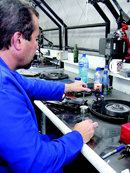Travel to Africa and follow the journey of a diamond--from a rock in the ground to the centerpiece of jewelry.
By: Elena Donovan Mauer
Step 1:MINING |
Yes, finding your diamond is a bit like |
|
Step 2:SORTING |
Rough diamonds are then taken to a sorting facility, where they’re categorized by their size, shape, quality and color. At the DTC Botswana, there are around 12,000 categories. Some of the sorting is done by machine, but much of it is double-checked with the human eye. Talk about meticulous! | |
Step 3:
CUTTING |
Diamonds are cut, then they’re sculpted into their faceted shapes using a polishing wheel coated in diamond dust. For larger stones, this process is done by hand and takes a craftsman about two weeks for one diamond. I watched this process at Rand in South Africa. Then, each stone is given a “grade” based on “The four C’s”: carat, cut, clarity and color. | |
Step 4:JEWERLY! |
For the last step, diamonds are sent to designers and stores, where they are set into jewelry that’s either been created in advance or is designed around the stone. Now that I’ve seen all the painstaking work, skill and care that goes into preparing a diamond for this state, I relish the one I wear even more! Ring by De Beers |
Rock Your World
Ready to buy that perfect diamond? Take these tips along.
CUT Often called the most critical of a stone’s four attributes, the term “cut” refers to its proportions. The more perfect the shape, the more sparkle the diamond will have.
COLOR Most diamonds are graded on a scale from D (colorless and the most pricey) to Z. Don’t stress: The untrained eye can’t tell the difference from D to H. Ask if you can look at your diamond away from the bright light to ensure you’re happy with its color.
CARAT This is a measure of your diamond’s weight; one carat equals 200 milligrams. For a stone that’s less than one carat, the weight will be measured in “points.” Remember: One carat equals 100 points, so a half carat rock weighs in at 50 points, and so on. Your stone’s setting can make it look bigger than it actually is.
CLARITY When you view your diamond through a magnifying loupe, you may see a tiny flaw (a white dot or a dark spot). Most of these “inclusions” are microscopic, but the fewer there are, the more rare and expensive the gem.








